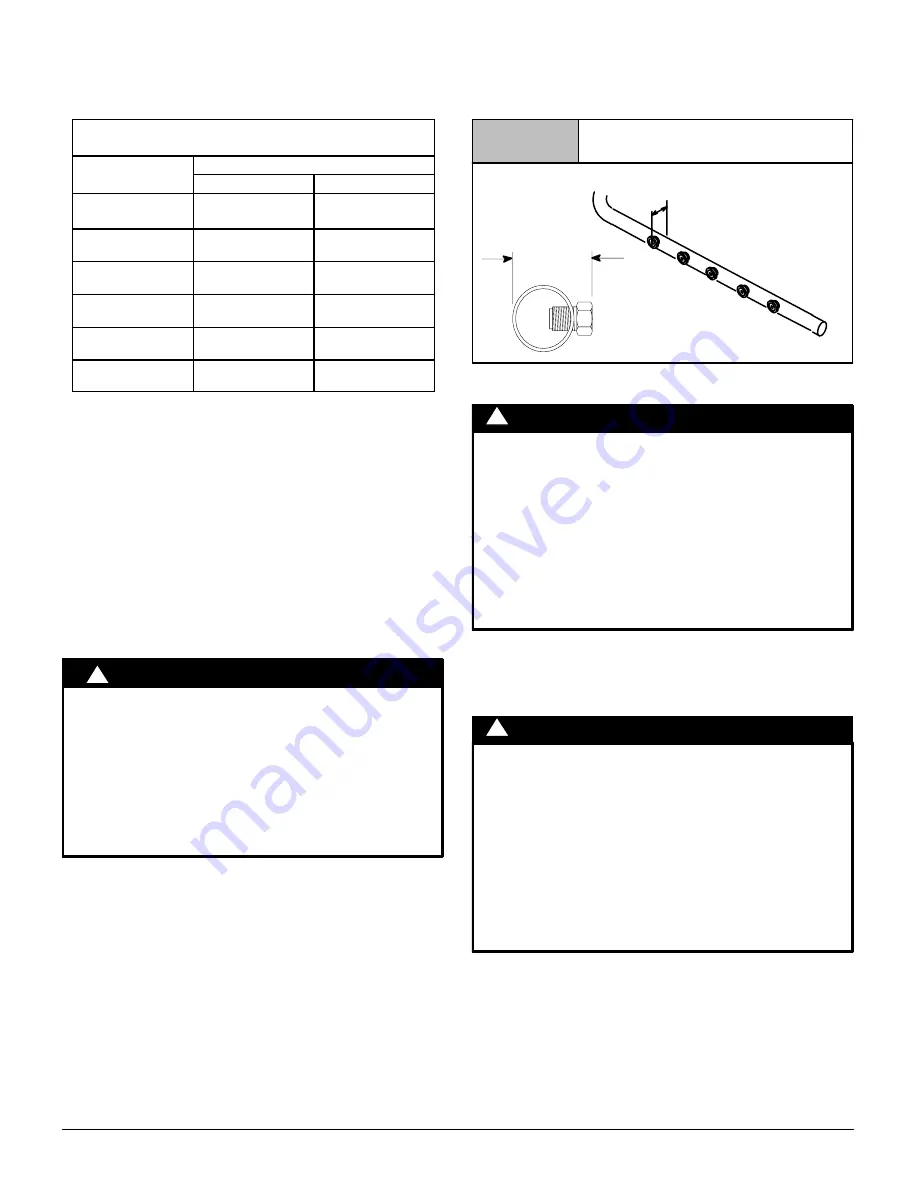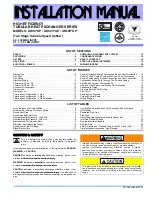
38
440 01 1051 02
Specifications are subject to change without notice.
3. For operation with Propane gas, gas orifices
MUST
be
changed and manifold pressure
MUST
be
maintained
as
per
Table 7.
Orifices can be ordered through our distributor.
(See Figure 39)
High Altitude Input Rate =
Nameplate Sea Level Input Rate x (Multiplier) *
{
Elevation
High Altitude Multiplier
Natural Gas
Propane Gas
2001
′
- 3000
′
{
(609.9
−
914.4)
{
0.95
0.90
3001
′
- 4000
′
(914.7
−
1219.2)
0.93
0.86
4001
′
- 5000
′
(1219.5
−
1524)
0.91
0.82
5001
′
- 6000
′
(1524.3
−
1828.8)
0.89
0.78
6001
′
- 7000
′
(1829.1
−
2133.6)
0.87
0.74
7001
′
- 8000
′
(2133.9
−
2438.4)
0.85
0.70
*
Based on mid
−
range of elevation.
High Altitude Air Pressure Switch
Altitudes over 4,000
′
(1219.2m) may require a different air
pressure switch than the one installed at the factory. Check parts
list for pressure switch and consult your distributor for part number
and availability. In Canada, provincial codes may govern
installation of switch. Check with governing authorities.
*
In the USA,
derating of these furnaces at 2% (Natural Gas)
and 4% (Propane Gas) has been tested and design
−
certified
by CSA.
{
In Canada
, the input rating must be derated 5% (Natural Gas)
and 10% (Propane Gas) for altitudes of 2,000 to 4,500 (609.6
to1371.6m) above sea level. Use the 2001 to 3000 (609.9 to
914.4m) column in
Table 6
and
Table 7
.
Changing Orifices for High Altitude
ELECTRICAL SHOCK, FIRE OR EXPLOSION
HAZARD
Failure to follow this warning could result in
personal injury, death, and/or property damage.
Turn OFF electric power at fuse box or service
panel and gas supply at manual valve in gas valve,
lockout and tag switch with a suitable warning
label, when installing orifices. Installation of
orifices requires a qualified service technician.
!
WARNING
NOTE:
Main burner orifices can be changed for high altitudes.
1. Disconnect gas line from gas valve.
2. Remove manifold from furnace.
3. Remove the orifices from the manifold and replace them
with properly sized orifices.
4. Tighten orifices so it is seated and gas tight.
(See
Figure 39
)
5. Reinstall manifold. Ensure burners do
NOT
bind on new
orifices.
Natural Gas Input Rating Check
SEE CHECKS AND ADJUSTMENTS, Natural Gas Input Rating
Check
in this manual.
Figure 39
Changing Orifices
Measure from face of orifice
to the back side of the
manifold.
1.11
″
(28.2mm)
1.21
″
(30.8mm)
Final Gas Piping Check
FIRE OR EXPLOSION HAZARD
Failure to follow this warning could result in
personal injury, death, and/or property damage.
Never test for gas leaks with an open flame. Use a
commercially available soap solution made
specifically for the detection of leaks to check all
connections. A fire or explosion could result
causing property damage, personal injury and/or
loss of life.
!
WARNING
1. The furnace and the equipment shut off valve must be
disconnected from the gas supply piping system during any
pressure testing of that system at test pressures in excess
of
1
/
2
″
PSIG. Close the manual shut
−
off valve before testing
at such pressures.
RISQUE D
‘
INDENDIE OU D
‘
EXPLOSION
Le non
−
respect des avertissements de sécurité
pourrait d
‘
entrainer des blessures graves, la mort
ou des dommages matériels.
Ne jamais utiliser une flamme nue por vérifier la
présence des fuites de gaz. Pour la vérification de
tous les joints, utiliser plutôt une solution
savonneuse commerciale fabriquée
spécifiquement pur la détection des fuites de gaz.
Un incendie ou une explosion peut entrainer des
dommages matériels, des blessures ou la mort.
!
AVERTISSEMENT
2. When installation is complete, test all pipe connections for
leaks with the gas pressure less than
1
/
2
″
PSIG to the gas
valve.
3. The furnace must be isolated from the gas supply system by
closing the equipment shut off valve during any pressure
testing of the gas supply system at test pressure equal to or
less than
1
/
2
″
PSI.
4. Apply a commercial soap solution to all joints to test for
leaks. Correct any leaks indicated by bubbles.
5. Correct even the smallest leak at once.
6. Check for leaks at gas valve and orifice connections to the
burner manifold while the furnace is operating.















































